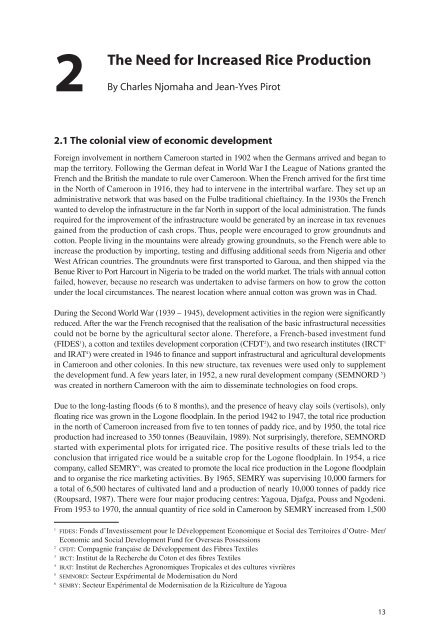The return of the water - IUCN
The return of the water - IUCN
The return of the water - IUCN
You also want an ePaper? Increase the reach of your titles
YUMPU automatically turns print PDFs into web optimized ePapers that Google loves.
2<br />
<strong>The</strong> Need for Increased Rice Production<br />
By Charles Njomaha and Jean-Yves Pirot<br />
2.1 <strong>The</strong> colonial view <strong>of</strong> economic development<br />
Foreign involvement in nor<strong>the</strong>rn Cameroon started in 1902 when <strong>the</strong> Germans arrived and began to<br />
map <strong>the</strong> territory. Following <strong>the</strong> German defeat in World War I <strong>the</strong> League <strong>of</strong> Nations granted <strong>the</strong><br />
French and <strong>the</strong> British <strong>the</strong> mandate to rule over Cameroon. When <strong>the</strong> French arrived for <strong>the</strong> first time<br />
in <strong>the</strong> North <strong>of</strong> Cameroon in 1916, <strong>the</strong>y had to intervene in <strong>the</strong> intertribal warfare. <strong>The</strong>y set up an<br />
administrative network that was based on <strong>the</strong> Fulbe traditional chieftaincy. In <strong>the</strong> 1930s <strong>the</strong> French<br />
wanted to develop <strong>the</strong> infrastructure in <strong>the</strong> far North in support <strong>of</strong> <strong>the</strong> local administration. <strong>The</strong> funds<br />
required for <strong>the</strong> improvement <strong>of</strong> <strong>the</strong> infrastructure would be generated by an increase in tax revenues<br />
gained from <strong>the</strong> production <strong>of</strong> cash crops. Thus, people were encouraged to grow groundnuts and<br />
cotton. People living in <strong>the</strong> mountains were already growing groundnuts, so <strong>the</strong> French were able to<br />
increase <strong>the</strong> production by importing, testing and diffusing additional seeds from Nigeria and o<strong>the</strong>r<br />
West African countries. <strong>The</strong> groundnuts were first transported to Garoua, and <strong>the</strong>n shipped via <strong>the</strong><br />
Benue River to Port Harcourt in Nigeria to be traded on <strong>the</strong> world market. <strong>The</strong> trials with annual cotton<br />
failed, however, because no research was undertaken to advise farmers on how to grow <strong>the</strong> cotton<br />
under <strong>the</strong> local circumstances. <strong>The</strong> nearest location where annual cotton was grown was in Chad.<br />
During <strong>the</strong> Second World War (1939 – 1945), development activities in <strong>the</strong> region were significantly<br />
reduced. After <strong>the</strong> war <strong>the</strong> French recognised that <strong>the</strong> realisation <strong>of</strong> <strong>the</strong> basic infrastructural necessities<br />
could not be borne by <strong>the</strong> agricultural sector alone. <strong>The</strong>refore, a French-based investment fund<br />
(FIDES 1 ), a cotton and textiles development corporation (CFDT 2 ), and two research institutes (IRCT 3<br />
and IRAT 4 ) were created in 1946 to finance and support infrastructural and agricultural developments<br />
in Cameroon and o<strong>the</strong>r colonies. In this new structure, tax revenues were used only to supplement<br />
<strong>the</strong> development fund. A few years later, in 1952, a new rural development company (SEMNORD 5 )<br />
was created in nor<strong>the</strong>rn Cameroon with <strong>the</strong> aim to disseminate technologies on food crops.<br />
Due to <strong>the</strong> long-lasting floods (6 to 8 months), and <strong>the</strong> presence <strong>of</strong> heavy clay soils (vertisols), only<br />
floating rice was grown in <strong>the</strong> Logone floodplain. In <strong>the</strong> period 1942 to 1947, <strong>the</strong> total rice production<br />
in <strong>the</strong> north <strong>of</strong> Cameroon increased from five to ten tonnes <strong>of</strong> paddy rice, and by 1950, <strong>the</strong> total rice<br />
production had increased to 350 tonnes (Beauvilain, 1989). Not surprisingly, <strong>the</strong>refore, SEMNORD<br />
started with experimental plots for irrigated rice. <strong>The</strong> positive results <strong>of</strong> <strong>the</strong>se trials led to <strong>the</strong><br />
conclusion that irrigated rice would be a suitable crop for <strong>the</strong> Logone floodplain. In 1954, a rice<br />
company, called SEMRY 6 ,was created to promote <strong>the</strong> local rice production in <strong>the</strong> Logone floodplain<br />
and to organise <strong>the</strong> rice marketing activities. By 1965, SEMRY was supervising 10,000 farmers for<br />
a total <strong>of</strong> 6,500 hectares <strong>of</strong> cultivated land and a production <strong>of</strong> nearly 10,000 tonnes <strong>of</strong> paddy rice<br />
(Roupsard, 1987). <strong>The</strong>re were four major producing centres: Yagoua, Djafga, Pouss and Ngodeni.<br />
From 1953 to 1970, <strong>the</strong> annual quantity <strong>of</strong> rice sold in Cameroon by SEMRY increased from 1,500<br />
1 FIDES: Fonds d’Investissement pour le Développement Economique et Social des Territoires d’Outre- Mer/<br />
Economic and Social Development Fund for Overseas Possessions<br />
2 CFDT: Compagnie française de Développement des Fibres Textiles<br />
3 IRCT: Institut de la Recherche du Coton et des fibres Textiles<br />
4 IRAT: Institut de Recherches Agronomiques Tropicales et des cultures vivrières<br />
5 SEMNORD: Secteur Expérimental de Modernisation du Nord<br />
6 SEMRY: Secteur Expérimental de Modernisation de la Riziculture de Yagoua<br />
13












